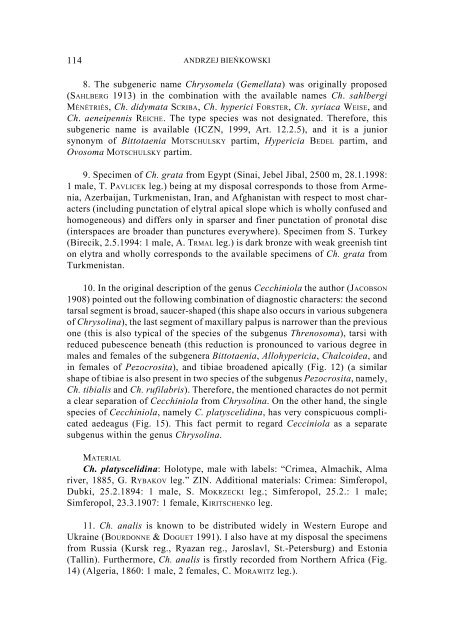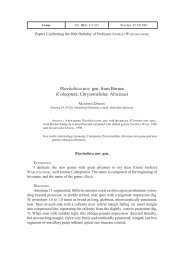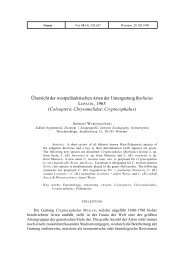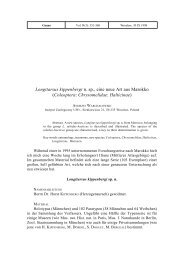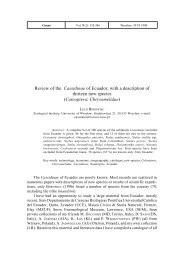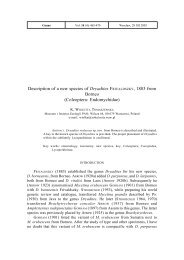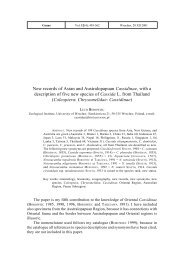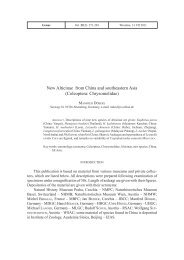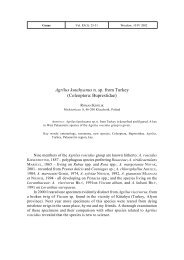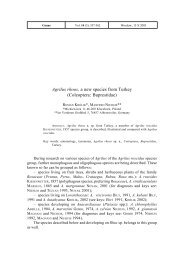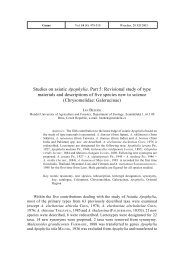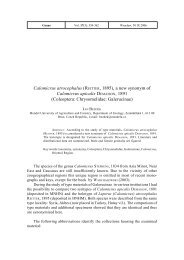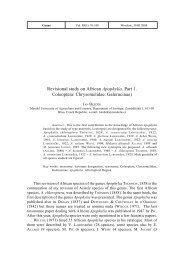A study on the genus Chrysolina MOTSCHULSKY, 1860, with a ...
A study on the genus Chrysolina MOTSCHULSKY, 1860, with a ...
A study on the genus Chrysolina MOTSCHULSKY, 1860, with a ...
Create successful ePaper yourself
Turn your PDF publications into a flip-book with our unique Google optimized e-Paper software.
114 ANDRZEJ BIEÑKOWSKI<br />
8. The subgeneric name Chrysomela (Gemellata) was originally proposed<br />
(SAHLBERG 1913) in <strong>the</strong> combinati<strong>on</strong> <strong>with</strong> <strong>the</strong> available names Ch. sahlbergi<br />
MÉNÉTRIÉS, Ch. didymata SCRIBA, Ch. hyperici FORSTER, Ch. syriaca WEISE, and<br />
Ch. aeneipennis REICHE. The type species was not designated. Therefore, this<br />
subgeneric name is available (ICZN, 1999, Art. 12.2.5), and it is a junior<br />
syn<strong>on</strong>ym of Bittotaenia <strong>MOTSCHULSKY</strong> partim, Hypericia BEDEL partim, and<br />
Ovosoma <strong>MOTSCHULSKY</strong> partim.<br />
9. Specimen of Ch. grata from Egypt (Sinai, Jebel Jibal, 2500 m, 28.1.1998:<br />
1 male, T. PAVLICEK leg.) being at my disposal corresp<strong>on</strong>ds to those from Armenia,<br />
Azerbaijan, Turkmenistan, Iran, and Afghanistan <strong>with</strong> respect to most characters<br />
(including punctati<strong>on</strong> of elytral apical slope which is wholly c<strong>on</strong>fused and<br />
homogeneous) and differs <strong>on</strong>ly in sparser and finer punctati<strong>on</strong> of pr<strong>on</strong>otal disc<br />
(interspaces are broader than punctures everywhere). Specimen from S. Turkey<br />
(Birecik, 2.5.1994: 1 male, A. TRMAL leg.) is dark br<strong>on</strong>ze <strong>with</strong> weak greenish tint<br />
<strong>on</strong> elytra and wholly corresp<strong>on</strong>ds to <strong>the</strong> available specimens of Ch. grata from<br />
Turkmenistan.<br />
10. In <strong>the</strong> original descripti<strong>on</strong> of <strong>the</strong> <strong>genus</strong> Cecchiniola <strong>the</strong> author (JACOBSON<br />
1908) pointed out <strong>the</strong> following combinati<strong>on</strong> of diagnostic characters: <strong>the</strong> sec<strong>on</strong>d<br />
tarsal segment is broad, saucer-shaped (this shape also occurs in various subgenera<br />
of <strong>Chrysolina</strong>), <strong>the</strong> last segment of maxillary palpus is narrower than <strong>the</strong> previous<br />
<strong>on</strong>e (this is also typical of <strong>the</strong> species of <strong>the</strong> sub<strong>genus</strong> Threnosoma), tarsi <strong>with</strong><br />
reduced pubescence beneath (this reducti<strong>on</strong> is pr<strong>on</strong>ounced to various degree in<br />
males and females of <strong>the</strong> subgenera Bittotaenia, Allohypericia, Chalcoidea, and<br />
in females of Pezocrosita), and tibiae broadened apically (Fig. 12) (a similar<br />
shape of tibiae is also present in two species of <strong>the</strong> sub<strong>genus</strong> Pezocrosita, namely,<br />
Ch. tibialis and Ch. rufilabris). Therefore, <strong>the</strong> menti<strong>on</strong>ed charactes do not permit<br />
a clear separati<strong>on</strong> of Cecchiniola from <strong>Chrysolina</strong>. On <strong>the</strong> o<strong>the</strong>r hand, <strong>the</strong> single<br />
species of Cecchiniola, namely C. platyscelidina, has very c<strong>on</strong>spicuous complicated<br />
aedeagus (Fig. 15). This fact permit to regard Cecciniola as a separate<br />
sub<strong>genus</strong> <strong>with</strong>in <strong>the</strong> <strong>genus</strong> <strong>Chrysolina</strong>.<br />
MATERIAL<br />
Ch. platyscelidina: Holotype, male <strong>with</strong> labels: “Crimea, Almachik, Alma<br />
river, 1885, G. RYBAKOV leg.” ZIN. Additi<strong>on</strong>al materials: Crimea: Simferopol,<br />
Dubki, 25.2.1894: 1 male, S. MOKRZECKI leg.; Simferopol, 25.2.: 1 male;<br />
Simferopol, 23.3.1907: 1 female, KIRITSCHENKO leg.<br />
11. Ch. analis is known to be distributed widely in Western Europe and<br />
Ukraine (BOURDONNE & DOGUET 1991). I also have at my disposal <strong>the</strong> specimens<br />
from Russia (Kursk reg., Ryazan reg., Jaroslavl, St.-Petersburg) and Est<strong>on</strong>ia<br />
(Tallin). Fur<strong>the</strong>rmore, Ch. analis is firstly recorded from Nor<strong>the</strong>rn Africa (Fig.<br />
14) (Algeria, <strong>1860</strong>: 1 male, 2 females, C. MORAWITZ leg.).


